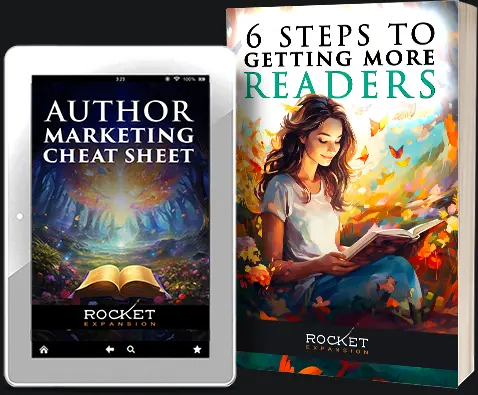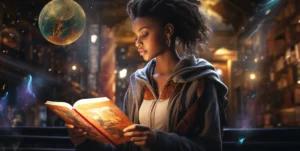Jaw Dropping Plot Twist Ideas Every Writer Needs to Know

You’ve got your characters to where you need them to be…but what next? Whichever way you look at it the story doesn’t seem to get to the next act in the way you imagine it should. Or the next act just seems too dead boring to publish!!
It’s time to think of some plot twist ideas to get your story back on track and wow your audience.
Caution: SPOILERS ahead! Enter at your own risk…but if you do get spoiled then you can take a pen and paper, read the book, and jot down how it leads up to the plot twist!
What is a Plot Twist
A plot twist is a literary device used to add an extreme change in a story to shock readers. It can appear anywhere in the story (but preferably not at the beginning since you’re still building the connection between the book and the reader).
Use a plot twist in the middle of a story and your readers will be enticed to keep reading to see where it goes next. Write the plot twist into the ending and you’ll leave a lasting impression on your readers.
The Plot Twist Ideas We’ve All Heard (And You Should Definitely Avoid)
Not only do you need to know what type of plot twist ideas exist, but you also need to know which to steer clear of. If not for the sake of your readers, but for the agents and publishers who will reject poorly executed books with cliché, gimmicky twists.
- Unexpectedly family
- Too good to defeat
- Beauty and the Beast
- From enemies to lovers
- Deus Ex Machina
- It was a dream the whole time!
Unexpectedly family
The hero of the story is related to the villain. What a small world we live in!
The most famous example of this is in Star Wars: The Empire Strikes Back when Darth Vader revealed that he was Luke’s father.
This type of plot twist idea can be interesting when used with little foreshadowing but it’s usually seen as predictable.
Too good to defeat
With this plot twist idea, either the villain can anticipate every move or they’re physically way too strong. This may lead some authors to a twist where the villain cannot be beaten. Which fans can see coming.
The problem with this twist is characters need to have weaknesses and depth for readers to engage with them. Having the antagonist be unbeatable can only lead to the protagonist’s failure or an implausible ending.
But! There are some examples with a ridiculously powerful antagonist that works.
In Norse mythology, the God Baldur’s death leads to Ragnarök. To try and prevent this, his mother, Frigg, made him invincible, except against mistletoe (which is a weird oversight that leaves room for weakness).
The reboot of the God of War franchise handles a new take on Baldur with depth and complex relationships, making it a plausible plot twist idea.
I’d hope that you, of everyone I’d faced, would finally make me feel something, but you can’t.
Baldur in God Of War (2018)
Beauty and the Beast
The beautiful lady falls for the ugly man. This can feel like lazy writing, and nothing is surprising about this.
By the way, are we sure that Belle didn’t have Stockholm Syndrome? Now, that would be a plot twist idea.
From enemies to lovers
Readers who enjoy the romance genre would’ve heard this trope a hundred times. Many love it, some can’t stand it.
The key to making this twist work is to back it up with a story that doesn’t lean on this trope too heavily and play into too many clichés surrounding it.
A creative twist on this exists in Elizabeth Lim’s Six Crimson Cranes. Shiori must use her powers and the help of the man she refused to marry to find her crane-turned brothers and save the kingdom.
Deus Ex Machina
Deus Ex Machina means ‘God from the machine’ and it was used in Greek and Roman plays as a literal crane to fly an angel into a scene to save the protagonist.
This type of twist comes out of left field to miraculously save the day without any real reason besides ‘an act of God.’
This is the easy way out in writing and is frowned upon by readers, agents, and publishers alike.
However, this type of twist may be forgiven in a comedic setting or action.
It works in the first Toy Story movie when Buzz and Woody miraculously are at the same gas station as the delivery truck of the restaurant they need to get to. Plus, it’s a story about toys coming to life. We won’t question anything too much there anyway.
It was a dream the whole time!
Speaking of the easy way out…the trope where the protagonist dreamt the whole story up. Or the main character was insane from the get-go and imagined the entire book’s events.
Nothing frustrates us more than instead of developing the lore of the story to find a plausible ending, the writer slams the ‘it was all a dream’ right in our faces.
Sometimes this terrible plot twist idea can be forgiven. For example, in The Wizard of Oz, the characters want to believe it was all a dream but the reader cannot be sure that it was.
Plot Twist Ideas That Will Shock and Infuriate Your Readers (don’t worry they’ll keep reading)
These plot twist idea types have the potential to take your readers on the ride of their lives, leaving them questioning everything they know and applauding your mastery.
- Hmm…this is fishy
- Chekhov’s gun
- Anagnorisis
- Peripeteia
- False Protagonist
- What goes around comes around
- Story in reverse
- Eucatastrophe
- No one is off limits
- Dead the whole time
- Saboteur!
- Flashbacks
- The gift that keeps taking
- It was, in fact, the main character the whole time!
- The Great Gasp-by
- I don’t trust you, narrator
Hmm…this is fishy
This clearly suspicious person must have been the killer, right? Psych!
The author left the bait out in the open and the reader went straight for it.
Red Herrings are all about subtly misleading the reader to believe one thing to then reveal a dead end. You want to distract the reader while still keeping evidence of the truth around.
Agatha Christie was a master at adding red herrings to her books, And Then There Were None being a prime example. She used the Ten Little Indians poem to throw the characters off the scent while also pointing to the actual killer.
Chekhov’s gun
One must never place a loaded rifle on the stage if it isn’t going to go off. It’s wrong to make promises you don’t mean to keep.
This means that the writer makes the reader aware of something and later reveals why it was important to know.
For example, in The Hunger Games, Suzanne Collins makes Katniss’ skill of spotting poisonous berries apparent, while also having a tense scene where Katniss goes off at Peeta for almost eating those berries.
Later, it comes in handy to secure double victors of the Hunger Games by tricking the Capitol.
Anagnorisis
This plot twist idea involves internal discovery. There is no physical or external change in the story. This usually comes before Peripeteia, which we’ll discuss next.
Anagnorisis is when the change in the story goes from ignorance to knowledge within a character.
A tragic example lies with the poor fellow Oedipus when he discovers who he really is. But we’ll dive into his sad tale further, in Peripeteia.
Peripeteia
Peripeteia means a sudden change in circumstance. This happens when a character is sealed on a certain path and a twist brings about a dramatic change.
To continue the rollercoaster ride being Oedipus’ story, Oedipus is fated to kill his father and marry his mother (yowza, right?).
The peripeteia occurs at the same time as the anagnorisis once Oedipus realizes who raised him was not his biological parents and he has unknowingly killed his father and married his mother.
He fought against his fate, and it led to him fulfilling it.
False Protagonist
The False Protagonist is the character the writer puts forward for the readers to assume is the main character. This character is usually killed off or left on the sidelines to make way for the real hero.
The most famous example is in A Game of Thrones (A Song of Ice and Fire) by George R. R. Martin. The reader is led to believe for the entire book that Ned Stark is the series’ protagonist, only for him to be killed off at the end of the book.
What goes around comes around
Is it not satisfying when the antagonist gets what’s coming to them?
Poetic Justice can be seen as uncreative to just have the villain fall to his own doing. But we’re human, we want the wrongdoings to be corrected!
For example, Macbeth wanted to be King so badly that he murdered his cousin, Duncan, leading to his eventual demise at the end.
Story in reverse
Reverse Chronology is about telling a story from the point of action and working backward to the cause. It’s a great way to keep readers on their toes.
Revealing information about the characters and the situation as you move back in time can create intrigue and drama.
Time’s Arrow by Martin Amis uses this plot twist idea well as he tells the story of Tod T. Friendly in reverse, revealing what the protagonist has been running from his whole life.
Eucatastrophe
Without J.R.R. Tolkien we wouldn’t have the safety net that sits between the good guys and their demise.
Tolkien came up with Eucatastrophe, which is an abrupt change at the end of the story that saves the protagonist.
It may seem like we’re discussing Deus Ex Machina again but, Eucatastrophe fits into the narrative of a story and has some foreshadowing.
For the example, we had to go with where this plot twist idea originated. When all may seem lost at the end of The Hobbit, Beorn arrives with the eagles to help the elves, dwarves, and men turn the tide against the goblins and come out victorious.
No one is off limits
When a character is well-written, and you just know the readers love them…nothing could rip their hearts out more than killing that character off.
But be careful not to kill off characters too often as the readers will get frustrated or try not to engage with your characters at all.
Veronica Roth’s Allegiant goes where most YA books wouldn’t think to, killing the hero.
Dead the whole time
These are usually the mysteries where the main character is looking for a family member or a close friend, only for it to be revealed that they were dead the entire time.
We Were Liars by E. Lockhart used this plot twist idea well as it left evidence of what happened to the characters during a fatal summer vacation. Some readers managed to figure out the plot twist but still felt the impact of the powerful ending.
See the world as it is, not as you wish it would be.
E. Lockhart, We Were Liars
Saboteur!
Nothing like a classic betrayal to leave jaws on the floor. An ally, or even the main character, can lie or double-cross to create conflict and tension that can change the direction of the story.
Do you know what it feels like to fall in love with your best friend’s fiancé? Rachel does. In Something Borrowed by Emily Giffin, Rachel crosses the boundaries of the girl code and has an affair with Darcy’s partner.
It’s a romance novel so we expect, you know, some romance, but the real twist happens at the end when Darcy admits to betraying her fiancé before finding out about Rachel’s affair. The drama!
Flashbacks
Using a flashback can be a fun way to reveal key information that flips the story upside down or flips the reader’s stomach.
It can be seen as cliché if it’s not plotted properly but it can really stick with you when it is.
A unique example would be the TV Show, How I Met Your Mother. The whole series is told with flashbacks, making the reveal of the mother and what happened to her all the more shocking (and controversial) at the end.
The gift that keeps taking
When the hero wished for a new strength, he never thought it would turn into his biggest weakness.
A good example of turning a gift into a curse is King Midas. Everything he touched turned to gold…even his daughter! The Greek sure know how to implement plot twist ideas.
The moral of this plot twist idea is, to be careful what you wish for…or at least word it better.
It was, in fact, the main character the whole time!
This one is best explained with an example.
Can we do a plot twist ideas list without naming Fight Club?
Although more critically acclaimed as a movie adaptation, the book, by Chuck Palahniuk, still provides a whirlwind twist that can descend the main character and reader into a bit of madness.
The premise is the nameless protagonist along with the antagonist, Tyler, form a fight club. We would say more but… we don’t want to break the first rule.
The Great Gasp-by
Anything that can go wrong, will go wrong.
Murphy’s Law
Sometimes to come up with the best plot twist idea, you need to think of what will give the best shock factor. You have to wonder, “What if everything goes wrong?”
What will make the reader gasp out loud?
The Great Gatsby, by F. Scott Fitzgerald, has some plot twists that leave readers intrigued about what the ending means in a real-world context and amazed by how the plot twist ideas were laid out.
Jay Gatsby tried so hard to be with the love of his life. But it ended with him being shot dead because the love of his life killed someone, and he took the blame.
I don’t trust you, narrator
The characters can do all the talking they want. They can lie, betray, and murder.
But what about an unreliable narrator…can we trust them?
Are they telling us the truth? Does the narrator even have all the facts? Are they too young to know any better?
Or are they merely toying with us?
As the writer, you can summersault the story to reveal true intentions at the end or use the unreliable narrator to help you craft an even better plot twist idea down the line.
In a list of plot twist ideas, we can’t not mention Gone Girl by Gillian Flynn. The book has many plot twists revolving around the 2 unreliable narrators in husband-and-wife Nick and Amy.
Besides the initial twist that Amy takes over as narrator, oh and she’s actually not dead, the story unravels and takes the reader on an insane roller coaster ride.
Tips on How to Use a Killer Plot Twist Idea
What’s worse? Having the reader go, “Yup, saw that one coming.” or “Well, that just ruined the entire story.”
Correct! Both are truly awful, and you need to avoid those responses at all costs.
So, here’s some tips to make sure your plot twist ideas turn out epic:
- Consistency: Your plot twist idea must match up with the story, otherwise it won’t make any sense
- Unexpected: It’s not really a plot twist if everyone sees it coming, so make sure to write down your first plot twist ideas and throw them out or flip it so it’s no longer cliché
- Foreshadow: Give the reader subtle hints to your twist so it all ties in later and makes for a good second read. If you’re heavy-handed with your hints then the reader will catch on, or worse, lose interest.
- Discovery: Let your characters stumble onto the plot twist naturally to make for an even juicier reveal. Remember, show and don’t tell!
- Work backward: If you have the plot twist idea to end all other plot twist ideas then, work backward from it to weave in your hints and evidence in the background of your story to make sure you cover all the ground you need to
- Let the plot twist idea come organically: Get to writing and let the plot twist idea come to you and surprise you. Then in a later draft, add in some foreshadowing.
- Be a magician: Some plot twist ideas can only be pulled off with some magic, and one of the biggest rules in magic is to misdirect the onlooker.
- Double whammy: The biggest shocker may come packaged in two, so after one plot twist idea is revealed, reveal another! The reader will be surprised by the first and reeling from the second.
- Take the reader on a rollercoaster: They’re not just for Disney World! Pair the plot twist ideas with intertwined emotions and action that will thrill the reader to no end.
- Keep the tension: Once the plot twist idea is exposed, don’t loosen the tension, keep the momentum of that scene going to have the reader clambering to turn the pages and find out how the story ends.
- Don’t go overboard: There can be too much of a good thing, and it applies to plot twist ideas too. It may be tempting to throw every good plot twist idea you have into your story, but it’ll exhaust, confuse, and frustrate your reader and flood your book with complexity.
- Be the reader: When coming up with your zinger plot twist idea, think about it from your target reader’s perspective. If you feel like you can see it coming, they probably will too.
- Use Readers: It’ll be hard to stay objective at times, so it’s a great idea to bring beta readers or an alpha reader in to test your plot twist ideas on (just don’t tell them there is one, so they won’t look for it)
- Study: Read books with plot twists and make notes on why they worked and why you liked them.
- A little bit of realism: Sometimes people’s stories can serve as writing inspiration, and you can use that in your stories. Read articles about real people, listen to stories of people in your life, or even use your own experiences to come up with plot twist ideas.
- You can’t please them all: No matter how hard you try, someone will figure out your plot twist idea and that’s okay! You can’t win them all, so make sure the plot twist idea sits within a well-written story and Plot Twist Finders should still stay on the journey till the end.
Story Devices To Use When You’re Stuck
You’re stuck and you don’t know where to go next to either discover your plot twist idea or bring it to fruition. Don’t fret, we have some story devices you could use to get you to the next act, or throw a spanner in the works and lead you to an even better story.
- Bring the Man With The Gun
- Sub-plotting
- Get fetchin’
- Glorious Allegory
- The Cliffhanger
Bring the Man with the Gun
When in doubt, have a man come through the door with a gun in his hand.
Raymand Chandler
Need some conflict and action to get your characters scrambling? You know who to call (not Ghostbusters).
Sub-plotting
If the main plot is drying up, try spicing it up with an action-packed subplot that changes the perspective of the story or distracts from the main plot twist idea enough to catch your characters, and readers, off guard.
Get fetchin’
Ran out of ideas for a subplot that leads to the main plot? Send your characters on a fetch quest.
Maybe your whole story is about fetching the item, like in Lord of The Rings.
Or maybe this fetch quest crosses paths and changes the main quest’s purpose.
Glorious Allegory
You know you want to mislead your readers, but how do you do it?
An Allegory helps to tie your story into a bigger meaning at the end, like with Life of Pi by Yann Martel. We’re so enthralled by the idea of Pi being on the boat with a tiger that we overlook the allegory that the zoo animals were actually people.
Or you could layer the allegory to add some perceptions like George Orwell did with Animal Farm. You know who the animals represent, and it makes it an even better read.
The Cliffhanger
Your story doesn’t have to end at all. Maybe the right move is to leave the door open for a sequel where you get to delve into what the plot twist idea means and how it changes everything.
Perhaps one of the biggest cliffhangers to date is the end of the 5th book in George R.R. Martin’s A Song of Ice and Fire series as fans have been waiting for the 6th entry for over a decade.
Writer’s block is no joke!
Books To Check Out If You’re Looking For More Plot Twist Ideas
Looking to read up on some books famous for their twists and turns? We’ve got you covered:
- The Murder of Roger Ackroyd by Agatha Christie
- Ender’s Game by Orson Scott Card
- The Light Between The Ocean by M.L. Stedman
- Maze Runner by James Dashner
- Lost Ground by Michiel Heyns
- Never Let Me Go by Kazuo Ishiguro
- The Couple Next Door By Shari Lapena
- Shadow of the Wind by Carlos Ruiz Zafon
- More Than This by Patrick Ness
- Red Queen By Victoria Aveyard
Biggest Plot Twist of All
Every author needs a website! We’re sure all your social media platforms, for example, Facebook Author Page, are great and effective but if you want to get more readers and more opportunities as an author, you need a website.
We love helping authors reach new heights with custom, user-friendly Author Website designs. Enquire by filling in this form and we’ll be happy to assist! No plot twists!

Want help with your author marketing? Get our FREE ebook and cheat sheet: 6 Steps To Getting More Readers.
By subscribing, you agree to get emails from me, Matt Ziranek. I’ll respect your privacy and you can unsubscribe any time.







